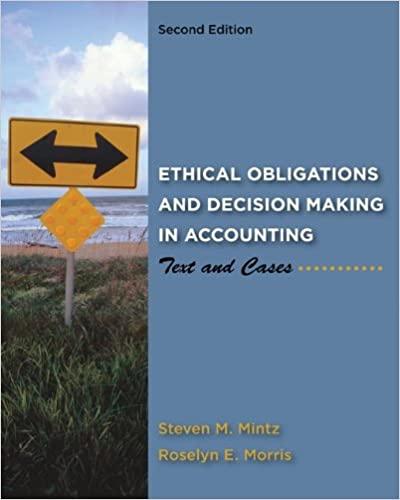Question
You are the vice president of finance of Waterway Corporation, a retail company that prepared two different schedules of gross margin for the first quarter
You are the vice president of finance of Waterway Corporation, a retail company that prepared two different schedules of gross margin for the first quarter ended March 31, 2020. These schedules appear below.
| Sales ($5 per unit) | Cost of Goods Sold | Gross Margin | ||||
| Schedule 1 | $159,200 | $143,878 | $15,322 | |||
| Schedule 2 | 159,200 | 149,550 | 9,650 |
The computation of cost of goods sold in each schedule is based on the following data.
| Units | Cost per Unit | Total Cost | ||||
| Beginning inventory, January 1 | 10,950 | $4.40 | $48,180 | |||
| Purchase, January 10 | 8,950 | 4.50 | 40,275 | |||
| Purchase, January 30 | 6,950 | 4.60 | 31,970 | |||
| Purchase, February 11 | 9,950 | 4.70 | 46,765 | |||
| Purchase, March 17 | 11,950 | 4.80 | 57,360 |
Ruth Lewis, the president of the corporation, cannot understand how two different gross margins can be computed from the same set of data. As the vice president of finance, you have explained to Ms. Lewis that the two schedules are based on different assumptions concerning the flow of inventory costs, i.e., FIFO and LIFO. Schedules 1 and 2 were not necessarily prepared in this sequence of cost flow assumptions. Prepare two separate schedules computing cost of goods sold and supporting schedules showing the composition of the ending inventory under both cost flow assumptions.
| Waterway Corporation Schedules of Cost of Goods Sold For the First Quarter Ended March 31, 2020 | ||||
| Schedule 1 First-in, First-out | Schedule 2 Last-in, First-out | |||
| Cost of Goods Available for SaleEnding InventoryCost of Goods SoldPurchasesBeginning Inventory | $ | $ | ||
| AddLess: Beginning InventoryCost of Goods SoldPurchasesCost of Goods Available for SaleEnding Inventory | ||||
| Cost of Goods Available for SaleCost of Goods SoldPurchasesEnding InventoryBeginning Inventory | ||||
| AddLess: Ending InventoryCost of Goods Available for SalePurchasesBeginning InventoryCost of Goods Sold | ||||
| Beginning InventoryPurchasesEnding InventoryCost of Goods Available for SaleCost of Goods Sold | $ | $ | ||
Schedules Computing Ending Inventory
| First-in, First-out (Schedule 1) | ||||
| at | $ | = | $ | |
| at | $ | = | ||
| $ | ||||
| Last-in, First-out (Schedule 2) | ||||
| at | $ | = | $ | |
| at | $ | = | ||
$  | ||||
Step by Step Solution
There are 3 Steps involved in it
Step: 1

Get Instant Access to Expert-Tailored Solutions
See step-by-step solutions with expert insights and AI powered tools for academic success
Step: 2

Step: 3

Ace Your Homework with AI
Get the answers you need in no time with our AI-driven, step-by-step assistance
Get Started


